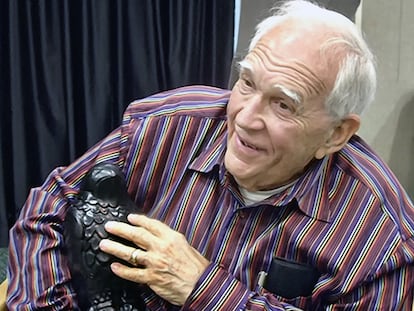When fiction becomes a kick in the stomach

Sodium cyanide is a white powder that is fatal when it comes into contact with hydrochloric acid in gastric juice.

Joe Gores (1931-2011) was an American crime novelist whose work shows a marked influence from Dashiell Hammett . He is responsible for the novel Hammett , in which Gores revives the author of The Maltese Falcon by turning him into a character in a story. which Wim Wenders adapted into a film. Here in Spain, the film was distributed under the title The Man from Chinatown.
This American author is part of a select group of cult storytellers, along with Joe R. Landsdale and Harlan Ellison, the author we discussed a few weeks ago . Joe Gores's stories are peppered with dark and macabre humor, like the one we're reading today. It's a short story titled "The Second Coming ," featuring a pair of snobs who visit San Quentin with the intention of witnessing a death in the gas chamber.
If there's one thing that stands out in this account, it's that Gores spares no detail when describing the execution in the gas chamber, with the gruesome chair under which they had placed "a bucket containing hydrochloric acid ," one of the elements that make up the deadly cocktail. The other element to consider is sodium cyanide, whose "pills the executioner would drop" into a conduit leading to the aforementioned bucket. In this way, Gores recounts, "hydrocyanic acid is formed that melts the intestines into a red-hot soup" as soon as it's inhaled. This is how things were in the San Quentin gas chamber, nicknamed "the smokehouse" by the prisoners.
We know that sodium cyanide is a white powder with the same appearance as table salt and a faint odor of bitter almonds. This culinary poison is fatal when it reaches the stomach and comes into contact with the hydrochloric acid in gastric juice. Our hydrochloric acid is present in a sufficient percentage to convert cyanide into hydrocyanic acid, a colorless gas and deadly poison that, in small doses, is fatal. It can kill a person in less than half a minute. However, what happens in Joe Gores's story is that the condemned man does not die in this short period of time, but rather lengthens the scene of his agony in detail.
Joe Gores captures every second, managing to make the hydrochloric acid in our gastric juices rise to the roof of our mouths and make us bitter for a long time. That's the power of fiction: when it's effective, it reaches the so-called gut-brain axis; a two-way connection involving neurotransmitters, chemical messengers that excite or relax, and that take us back and forth through the corridors of memory . Authors like Joe Gores manage to hit the exact key to get this axis moving, and we experience what's being narrated as if it were real. That's when our stomachs start to growl, and the fiction becomes forever rooted in the storage room of our subconscious.
The Stone Axe is a section where Montero Glez , with a desire for prose, exercises his particular siege on scientific reality to demonstrate that science and art are complementary forms of knowledge.
Do you want to add another user to your subscription?
If you continue reading on this device, it will not be possible to read it on the other device.
ArrowIf you want to share your account, upgrade to Premium, so you can add another user. Each user will log in with their own email address, allowing you to personalize your experience with EL PAÍS.
Do you have a business subscription? Click here to purchase more accounts.
If you don't know who's using your account, we recommend changing your password here.
If you decide to continue sharing your account, this message will be displayed indefinitely on your device and the device of the other person using your account, affecting your reading experience. You can view the terms and conditions of the digital subscription here.

Journalist and writer. His notable novels include "Champagne Thirst," "Black Powder," and "Mermaid Flesh."
EL PAÍS







